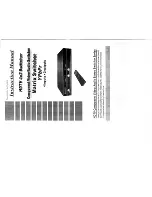
Central Switching Module PTN-CSM310-A/PTN-CSM540-A 15
Release 03 05/2020
2.2.3
Central Node Switching
The switch on the CSM is non-blocking and has following data bus:
CSM310-A:
4 x '1 Gbps / 10 Gbps' ports
24 x '1 Gbps' ports
CSM540-A:
60 x '1 Gbps / 10 Gbps' ports
Which node slot supports which speeds and bandwidths is described in the
‘Dragon PTN
Bandwidth Overview’
manual, see Ref. [100] in Table 2.
The onboard switch supports the features described in §1.1.
2.2.4
Management Channel / DCN Channel / HiProvision Interface
The management or DCN channel (=Data Communication Network) is a dedicated channel
needed by HiProvision to configure, monitor and manage the Dragon PTN network.
The management channel is built up dynamically during the HiProvision Discovery phase. This
channel is a collection of inter-node MPLS-TP WAN connections. All the Dragon PTN
management packets travelling over the Dragon PTN network will have a high priority QoS
(=Quality of Service) to ensure that these packets always reach their destination.
NOTE:
See also §2.1.5, for the Discovery function, see Ref. [2Mgt] in Table 2;
2.2.5
Synchronization / Clock Distribution / Network Timing
The Dragon PTN network provides a number of mechanisms to perform synchronization /
clock distribution / network timing. The CSM makes sure that all the IFMs included in the node
are synchronized. See the table below for an overview of the mechanisms.
Table 9
Synchronization / Clock Distribution / Network Timing Overview
Mechanism
Domain
What is
synchronized?
Purpose
SyncE
Network wide
Clock Frequency
Distribute a synchronous clock, based on a PRC (=Primary
Reference Clock), network wide over all the nodes that need it.
PTP IEEE 1588v2 Network wide
Timestamping
A protocol to synchronize real-time clocks (timestamping) in
Dragon PTN network elements and/or connected devices.
a.
SyncE (=Synchronous Ethernet)
SyncE distributes a synchronous clock, based on a PRC, network wide over all the nodes that
need such a synchronous signal. The PRC is a very stable high quality clock that can be used as
a reference for network wide clock distribution.
In HiProvision, an operator can configure (see manual Ref. [2Net] in Table 2) a clock
distribution tree with the participating nodes and IFMs together with the necessary clock
priorities. A clock is recovered from an incoming data signal on an IFM interface port (e.g.
Data1 on a 4-GC-LW module,) and forwarded to the CSM via the backplane, see figure below.











































